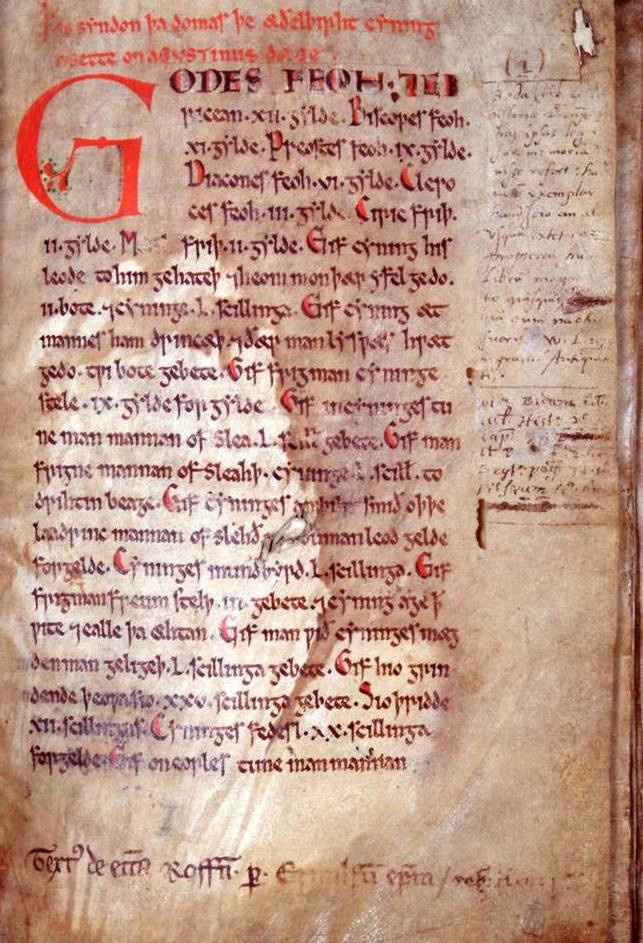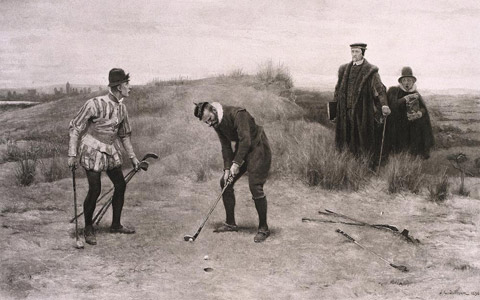|
Wihtred's Laws
The Law of Wihtred is an early English legal text attributed to the Kentish king Wihtred (died 725). It is believed to date to the final decade of the 7th century and is the last of three Kentish legal texts, following the Law of Æthelberht and the Law of Hlothhere and Eadric. It is devoted primarily to offences within and against the church, as well as church rights and theft. Provenance The prologue of the text and the red manuscript rubric attribute the law to Wihtred (died 725), king of Kent. Wihtred reigned from around or just after 690 to 725, and the text suggests he issued the law's provisions in 695.Oliver, ''Beginnings of English Law'', p. 165 Like the other Kentish codes, the Law of Wihtred survives in only one manuscript, known as the "Rochester Codex" or '' Textus Roffensis''. This is a compilation of Anglo-Saxon historic and legal material drawn together in the early 1120s under the supervision of Ernulf, bishop of Rochester. Wihtred's law occupies folios 5v ... [...More Info...] [...Related Items...] OR: [Wikipedia] [Google] [Baidu] |
Wihtred Of Kent
Wihtred ( la, Wihtredus) ( – 23 April 725) was king of Kent from about 690 or 691 until his death. He was a son of Ecgberht I and a brother of Eadric. Wihtred ascended to the throne after a confused period in the 680s, which included a brief conquest of Kent by Cædwalla of Wessex, and subsequent dynastic conflicts. His immediate predecessor was Oswine, who was probably descended from Eadbald, though not through the same line as Wihtred. Shortly after the start of his reign, Wihtred issued a code of laws—the Law of Wihtred—that has been preserved in a manuscript known as the ''Textus Roffensis''. The laws pay a great deal of attention to the rights of the Church (of the time period), including punishment for irregular marriages and for pagan worship. Wihtred's long reign had few incidents recorded in the annals of the day. He was succeeded in 725 by his sons, Æthelberht II, Eadberht I, and Alric. Kent in the late seventh century The dominant force in la ... [...More Info...] [...Related Items...] OR: [Wikipedia] [Google] [Baidu] |
Archbishop Of Canterbury
The archbishop of Canterbury is the senior bishop and a principal leader of the Church of England, the ceremonial head of the worldwide Anglican Communion and the diocesan bishop of the Diocese of Canterbury. The current archbishop is Justin Welby, who was enthroned at Canterbury Cathedral on 21 March 2013. Welby is the 105th in a line which goes back more than 1400 years to Augustine of Canterbury, the "Apostle to the English", sent from Rome in the year 597. Welby succeeded Rowan Williams. From the time of Augustine until the 16th century, the archbishops of Canterbury were in full communion with the See of Rome and usually received the pallium from the pope. During the English Reformation, the Church of England broke away from the authority of the pope. Thomas Cranmer became the first holder of the office following the English Reformation in 1533, while Reginald Pole was the last Roman Catholic in the position, serving from 1556 to 1558 during the Counter-Reformation. ... [...More Info...] [...Related Items...] OR: [Wikipedia] [Google] [Baidu] |
Germanic Legal Codes
Germanic law is a scholarly term used to described a series of commonalities between the various law codes (the ''Leges Barbarorum'', 'laws of the barbarians', also called Leges) of the early Germanic peoples. These were compared with statements in Tacitus and Julius Caesar, Caesar as well as with high and late medieval law codes from Germany and Scandinavia. Until the 1950s, these commonalities were held to be the result of a distinct Germanic legal culture. Scholarship since then has questioned this premise and argued that many "Germanic" features instead derive from provincial Roman law. Although most scholars no longer hold that Germanic law was a distinct legal system, some still argue for the retention of the term and for the potential that some aspects of the ''Leges'' in particular derive from a Germanic culture. While the ''Leges Barbarorum'' were written in Latin and not in any Germanic languages, Germanic vernacular, codes of Anglo-Saxon law were produced in Old English ... [...More Info...] [...Related Items...] OR: [Wikipedia] [Google] [Baidu] |
Anglo-Saxon Law
Anglo-Saxon law (Old English ''ǣ'', later ''lagu'' "law"; dōm "decree, judgment") is a body of written rules and customs that were in place during the Anglo-Saxon period in England, before the Norman conquest. This body of law, along with early Medieval Scandinavian law and Germanic law, descended from a family of ancient Germanic custom and legal thought. However, Anglo-Saxon law codes are distinct from other early Germanic legal statements—known as the ''leges barbarorum'', in part because they were written in Old English instead of in Latin. The laws of the Anglo-Saxons were the second in medieval Western Europe after those of the Irish to be expressed in a language other than Latin. Overview Early Germanic law Inked records of early Germanic law (''leges barbarorum'') were, in many ways, the product of Roman influence. Throughout the early middle ages, as various " Teutonic", or Germanic, tribes on the continent came into closer and more peaceful contact with the high ... [...More Info...] [...Related Items...] OR: [Wikipedia] [Google] [Baidu] |
Wergild
Weregild (also spelled wergild, wergeld (in archaic/historical usage of English), weregeld, etc.), also known as man price (blood money), was a precept in some archaic legal codes whereby a monetary value was established for a person's life, to be paid as a fine or as compensatory damages to the person's family if that person was killed or injured by another. Overview A weregild was a defined value placed on every man graded according to rank, used as a basis of a fine or compensation for murder, disablement, injury (or certain other serious crimes) against that person. It was assessed from the guilty party, payable as restitution to the victim's family. The weregild was codified, for example, under Frankish Salic Code. Weregild payment was an important legal mechanism in early Germanic society; the other common form of legal reparation at this time was blood revenge. The payment was typically made to the family or to the clan. Similar to the way a payment was made to family, ... [...More Info...] [...Related Items...] OR: [Wikipedia] [Google] [Baidu] |
Paenitentiale Theodori
The ''Paenitentiale Theodori'' (also known as the ''Iudicia Theodori'' or ''Canones Theodori'') is an early medieval penitential handbook based on the judgements of Archbishop Theodore of Canterbury. It exists in multiple versions, the fullest and historically most important of which is the ''U'' or ''Discipulus Umbrensium'' version (hereafter the ''Paenitentiale Umbrense''), composed (probably) in Northumbria within approximately a decade or two after Theodore's death. Other early though far less popular versions are those known today as the ''Capitula Dacheriana'', the ''Canones Gregorii'', the ''Canones Basilienses'', and the ''Canones Cottoniani'', all of which were compiled before the ''Paenitentiale Umbrense'' probably in either Ireland and/or England during or shortly after Theodore's lifetime. Background It is generally accepted by scholars today that Theodore himself is not responsible for any of the penitential works ascribed to him. Rather, a certain associate of Th ... [...More Info...] [...Related Items...] OR: [Wikipedia] [Google] [Baidu] |
Sabbath Desecration
Sabbath desecration is the failure to observe the Biblical Sabbath and is usually considered a sin and a breach of a holy day in relation to either the Jewish ''Shabbat'' (Friday sunset to Saturday nightfall), the Sabbath in seventh-day churches, or to the Lord's Day (Sunday), which is recognized as the Christian Sabbath in first-day Sabbatarian denominations. Judaism According to Ten Commandments, Mosaic Law, to desecrate ''shabbat'' intentionally, despite warning, is a List of capital crimes in the Torah, capital offense (Book of Exodus, Exodus 31:14). All work was prohibited during ''shabbat'', even minor tasks, such as "gathering wood" (Book of Numbers, Numbers 15:32-36). Since the decline of classical ''semicha'' (rabbinic ordination) in the 4th century C.E., the traditional Jewish view is that beth din, Jewish courts have lost the power to rule on criminal cases. As such, it would be practically impossible for Orthodox Judaism, Orthodox courts to enforce the death penalt ... [...More Info...] [...Related Items...] OR: [Wikipedia] [Google] [Baidu] |
Christian Sabbath
Sabbath in Christianity is the inclusion in Christianity of a Sabbath, a day set aside for rest and worship, a practice that was mandated for the Israelites in the Ten Commandments in line with God's blessing of the seventh day (Saturday) making it holy, "because on it God rested from all his work that he had done in creation". The practice was associated with the assembly of the people to worship in synagogues on the day known as Shabbat. Early Christians, at first mainly Jewish, observed the seventh-day Sabbath with prayer and rest, but gathered on the seventh day, Saturday, reckoned in Jewish tradition as beginning, like the other days, at sunset on what would now be considered the Friday evening. At the beginning of the second century Ignatius of Antioch approved non-observance of the Sabbath. The now majority practice of Christians is to observe Sunday, called the Lord's Day, rather than the Jewish seventh-day Sabbath as a day of rest and worship. Possibly because of a movemen ... [...More Info...] [...Related Items...] OR: [Wikipedia] [Google] [Baidu] |
Christian Fasting
Fasting is the abstention from eating and sometimes drinking. From a purely physiological context, "fasting" may refer to the metabolic status of a person who has not eaten overnight (see "Breakfast"), or to the metabolic state achieved after complete digestion and absorption of a meal. Metabolic changes in the fasting state begin after absorption of a meal (typically 3–5 hours after eating). A diagnostic fast refers to prolonged fasting from 1 to 100 hours (depending on age) conducted under observation to facilitate the investigation of a health complication, usually hypoglycemia. Many people may also fast as part of a medical procedure or a check-up, such as preceding a colonoscopy or surgery, or before certain medical tests. Intermittent fasting is a technique sometimes used for weight loss that incorporates regular fasting into a person's dietary schedule. Fasting may also be part of a religious ritual, often associated with specifically scheduled fast days, as determined b ... [...More Info...] [...Related Items...] OR: [Wikipedia] [Google] [Baidu] |
Theodore Of Tarsus
Theodore of Tarsus ( gr, Θεόδωρος Ταρσοῦ; 60219 September 690) was Archbishop of Canterbury from 668 to 690. Theodore grew up in Tarsus, but fled to Constantinople after the Persian Empire conquered Tarsus and other cities. After studying there, he relocated to Rome and was later installed as the Archbishop of Canterbury on the orders of Pope Vitalian. Accounts of his life appear in two 8th-century texts. Theodore is best known for his reform of the English Church and establishment of a school in Canterbury. Sources Theodore's life can be divided into the time before his arrival in Britain as Archbishop of Canterbury, and his archiepiscopate. Until recently, scholarship on Theodore had focused on only the latter period since it is attested in Bede's '' Ecclesiastical History of the English'' (''c'' 731), and also in Stephen of Ripon's ''Vita Sancti Wilfrithi'' (early 700s), whereas no source directly mentions Theodore's earlier activities. However, Michael Lapidg ... [...More Info...] [...Related Items...] OR: [Wikipedia] [Google] [Baidu] |
Minster (church)
Minster is an honorific title given to particular churches in England, most notably York Minster in Yorkshire, Westminster Abbey in London and Southwell Minster in Nottinghamshire. The term ''minster'' is first found in royal foundation charters of the 7th century, when it designated any settlement of clergy living a communal life and endowed by charter with the obligation of maintaining the daily office of prayer. Widespread in 10th-century England, minsters declined in importance with the systematic introduction of parishes and parish churches from the 11th century onwards. The term continued as a title of dignity in later medieval England, for instances where a cathedral, monastery, collegiate church or parish church had originated with an Anglo-Saxon foundation. Eventually a minster came to refer more generally to "any large or important church, especially a collegiate or cathedral church". In the 21st century, the Church of England has designated additional minsters by b ... [...More Info...] [...Related Items...] OR: [Wikipedia] [Google] [Baidu] |
Altar
An altar is a table or platform for the presentation of religious offerings, for sacrifices, or for other ritualistic purposes. Altars are found at shrines, temples, churches, and other places of worship. They are used particularly in paganism, Christianity, Buddhism, Hinduism, Judaism, modern paganism, and in certain Islamic communities around Caucasia and Asia Minor. Many historical-medieval faiths also made use of them, including the Roman, Greek, and Norse religions. Etymology The modern English word '' altar'' was derived from Middle English '' altar'', from Old English '' alter'', taken from Latin '' altare'' ("altar"), probably related to '' adolere'' ("burn"); thus "burning place", influenced by '' altus'' ("high"). It displaced the native Old English word '' wēofod''. Altars in antiquity File:Tel Be'er Sheva Altar 2007041.JPG, Horned altar at Tel Be'er Sheva, Israel. File:3217 - Athens - Sto… of Attalus Museum - Kylix - Photo by Giovanni Dall'Orto, ... [...More Info...] [...Related Items...] OR: [Wikipedia] [Google] [Baidu] |





